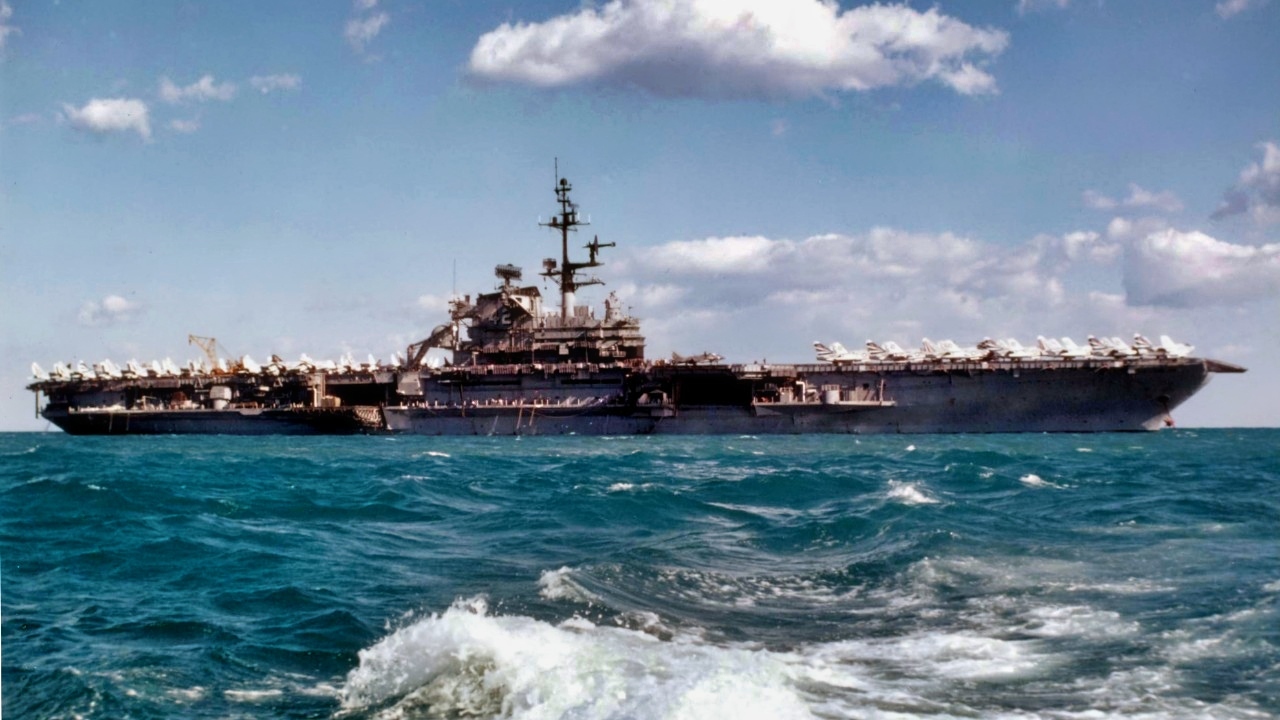Key Points and Summary on Midway-Class – The U.S. Navy’s Midway-class ships, commissioned just after WWII, were America’s first aircraft carriers with armored flight decks, a direct response to British designs.
-These massive carriers, though plagued by design compromises like a low freeboard that made them notoriously “wet,” became the workhorses of the fleet for nearly 50 years.
-The lead ship, USS Midway, served from 1945 through Operation Desert Storm in 1991, and its air wing scored both the first and last MiG kills of the Vietnam War, cementing the class’s powerful, if imperfect, legacy.
Meet the Midway-Class Aircraft Carrier
The United States Navy’s Midway-class aircraft carriers were the first to have an armor-plated flight deck. The Midway class consisted of three United States Navy aircraft carriers.
The lead ship, USS Midway, was commissioned in September 1945 and decommissioned in 1992. The USS Franklin D. Roosevelt was commissioned in October 1945 and retired in 1977. The USS Coral Sea was commissioned in April 1947 and decommissioned in 1990.
The USS Midway’s service life is a testament to how much the United States relied on its carriers. She arrived at the end of the Second World War and served through Korea but in the Atlantic, Vietnam, and Desert Storm.
She sailed with the grandsons of Navy personnel who were around in 1945.
Design of the Midway-Class Aircraft Carrier
In 1940, the design of the Midway was a study to determine the effect of an armored flight deck on an Essex-class carrier.
However, it was learned that this would reduce the size of the air group—the ship would have an air group of 64, compared to 90–100 for the standard Essex-class fleet carriers.
The designers had to make the ship much bigger.
At first, the Midway class could carry 130 aircraft. However, this number was too large for command and control of the air assets, so the air group’s numbers were reduced. This also allowed the ship to accommodate the first jet aircraft that would come shortly afterward.
However, the carrier’s design had several flaws the Navy never fixed, resulting in challenging and expensive upgrade and maintenance. The ships were wet due to an unusually low Freeboard for their size.
Freeboard is defined as the distance from the waterline to the upper deck level, measured at the lowest point of sheer where water can enter the boat or ship.
The Midway class was also very cramped and crowded. The ship’s width was so large it wouldn’t fit through the Panama Canal.
USS Midway Specs
At the time of their commissioning, the Midway class carriers were among the largest ships ever built.
Displacement: 60,000 tons (full load) / 46,000 tons (light)
Length: 295 meters (968 ft) overall / 275 m (901 ft) waterline
Beam: 37 meters (121 ft) – waterline
Draft: 10 meters (33 ft)
Speed: 33 knots (61 km/h), max.
Complement: up to 4,100 (ship + airwing)
Propulsion: 12 x 565 psi boilers
Westinghouse steam turbines (212,000 shaft horsepower / 158 MW)
4 shafts / 4 propellers
Armament:
As built: 18 x 5 inches (127 mm)/54 caliber guns, 21 x 40 mm Bofors quad guns,
28 x 20 mm Oerlikon twin guns
After refit: 2 x Mk.29 launchers for RIM-7 Sea Sparrow Missiles (2 x 8 missiles + reload), 2 x Mk.15 Phalanx Close-In-Weapon System (CIWS)
Aviation: Full flight deck with island and hangar deck for up to 100 aircraft
The Midway-Class Were Cutting Edge At the Time
These ships were designed to fight the Japanese Imperial Navy. Unfortunately, the USS Midway was nine days late, as the Japanese signed Unconditional Surrender documents in Tokyo Harbor before she could get in the fight.
However, she was the first to have an armored flight deck. They were the only ships capable of operating nuclear strike aircraft in their early years.
But as they aged, despite their size the Midway class were too small to transition from the F-4 Phantoms to the F-14 Tomcats.
The Legacy
“They were the perfect ships for what the U.S. Navy needed,” said Mike Fabey, America’s Naval reporter for Jane’s. “We needed a much larger carrier to maintain our global navy.”
Although too late for World War II, and kept in the Mediterranean during Korea as a deterrent to the Soviet Union, all three ships saw extensive combat action during the war in Vietnam. The USS Midway shot down the first and last MiG fighter during the war.
The USS Midway would go on to serve in Desert Storm, but she would be retired in 1992. The other two Midway-class ships had already been retired. The USS Midway is now a floating museum in San Diego.
About the Author:
Steve Balestrieri is a National Security Columnist. He served as a US Army Special Forces NCO and Warrant Officer. In addition to writing on defense, he covers the NFL for PatsFans.com and is a member of the Pro Football Writers of America (PFWA). His work was regularly featured in many military publications.
Military Matters
Russia’s Su-57 Felon Stealth Fighter Is a Waste of Rubles











Pingback: D-21 Mach 3 Spy Drone Summed Up in 4 Words - National Security Journal